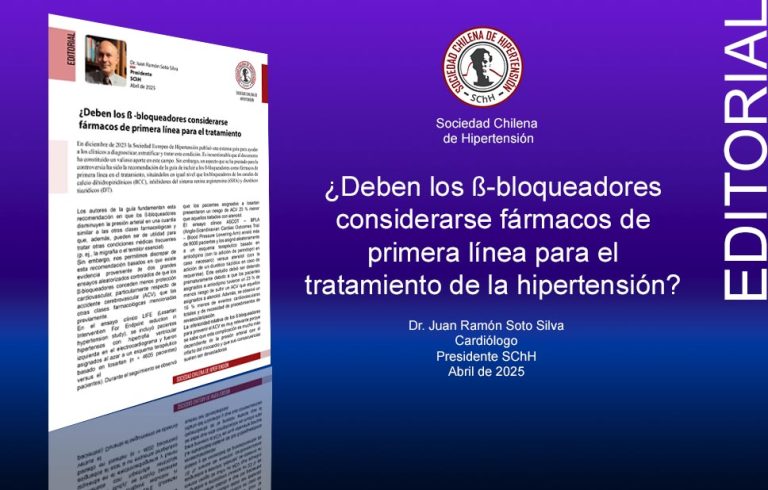
In December 2023 The European Hypertension Society published an extensive guide to help clinicians to diagnose, Stratify and treat this condition. It is unquestionable that the document has constituted a valuable contribution in this field. However, An aspect that has been provided for the controversy has been the guide's recommendation to include b-blockers as first-line drugs in treatment, placing them on the same level as the blockers of the dihydropiridin calcium channels (BCC), RENINA ANGIOTENSIN SYSTEM INHIBERS (iSRA) and thiazide diuretics (DT).
The authors of the guide support this recommendation in which the b-blockers decrease blood pressure in a amount similar to the other pharmacological classes and that, besides, They can be useful to deal with other frequent medical conditions (p. ej., migraine or essential tremor).
However, We allow ourselves to disagree with this recommendation based on the fact that there is evidence from two large controlled randomized trials that b-blockers grant less cardiovascular protection, particularly regarding stroke (ACV), that the other pharmacological classes mentioned above.
In the Life clinical trial (Losartan Intervention For Endpoint reduction in hypertension study), Hypertensive patients with left ventricular hypertrophy were included in the electrocardiogram and were randomly assigned to a therapy scheme based on Losartan (n = 4605 patients) versus the athenolol b-blocker (n = 4588 patients). During the follow -up it was observed that patients assigned to Losartan presented a risk of stroke 25 % less than those treated with athenolol.
The Ascot - BPLA clinical trial (Anglo-Scandinavian Cardiac Outcomes Trial – Blood Pressure Lowering Arm) He enrolled more than 9000 patients and randomly assigned them to a therapeutic scheme based on amlodipine (with the addition of Permondopril if necessary) versus atenolol (with the addition of a thiazic diuretic in case of being required). This study had to be arrested prematurely because patients assigned to amlodipine had a 23 % of less risk of suffering a stroke than those assigned to Athenolol. Besides, A one was observed 16 % less of total cardiovascular events and need for revascularization procedures.
The relative inferiority of b-blockers to prevent stroke is very relevant because it is known that this complication is much more dependent on blood pressure than myocardial infarction and that its consequences are usually devastating.
It could be argued that Athenolol is not a good b-blocker. However, It is a B blocker1 selective, In general similar to bisoprolol or metoprolol. It could be argued that third generation b-blockers (that is to say, With vasodilator effect such as carvedilol or nebivolol) They are more effective, But this has not been demonstrated in any clinical trial so far.
Nevertheless, B-blockers are useful drugs in four frequent situations in cardiology:
- Heart failure with reduced ejection fraction.
- Taquiarritmias supraventriculares (p. ej., atrial fibrillation).
- Symptomatic coronary disease (that is to say, To control angina pectoris).
- Post infarction patients of the myocardium.
Its preferred use could also be considered in the hyperadrenergic patient (Chronic anxiety) with high heart frequencies at rest (>80/min).
Another relevant aspect that must be considered is that of the adverse effects. Since arterial hypertension is an essentially asymptomatic condition, The medications that are prescribed for treatment must, in general, Be as exempt as possible of collateral effects. Unfortunately, It is not the case of b-blockers who have numerous adverse reactions such as fatigue, hibernation, Sleep disorders, Bradycardia, dizziness, dyspnoea, Erectile dysfunction, higher incidence of diabetes mellitus, among others. It is for this reason that among patients they have a high degree of abandonment.
To complete, Our position is that, In hypertensive patients without any of the comorbidities mentioned above, First -line pharmacological classes must continue to be BCC, The Isra (angiotensin converting enzyme inhibitors or angiotensin II receptive blockers) y los dt. The foundation is that b-blockers provide lower protection against stroke than the other available pharmacological classes, And the prevention of the various cardiovascular events is the main objective of any antihypertensive treatment.
References
- Mancia G, Kreutz r, Brunström m, et al. 2023 ESH Guidelines for the management of arterial hypertension The Task Force for the management of arterial hypertension of the European Society of Hypertension: Endorsed by the International Society of Hypertension (ISH) and the European Renal Association (ERA). J Hypertens. 2023; 41:1874-2071.
- Dahlöf b, Devereux RB, The source see, et al. Cardiovascular morbidity and mortality in the Losartan Intervention For Endpoint reduction in hypertension study (LIFE): a randomised trial against atenolol. Lancet. 2002; 359:995-1003.
- Dahlöf b, Sever PS, Poulter NR, et al. Prevention of cardiovascular events with an antihypertensive regimen of amlodipine adding perindopril as required versus atenolol adding bendroflumethiazide as required, in the Anglo-Scandinavian Cardiac Outcomes Trial-Blood Pressure Lowering Arm (ASCOT-BPLA): a multicentre randomised controlled trial. Lancet. 2005; 366:895-906.
- Messerli FH, Bangalore S, Turn JM. β blockers switched to first-line therapy in hypertension. Lancet. 2023; 402:1802- 04.
- Shantsila is, Beevers DG, Lip GYH. For Debate: The 2023 European Society of Hypertension guidelines – cause for concern. J Hypertens. 2024; 42:948-50.


